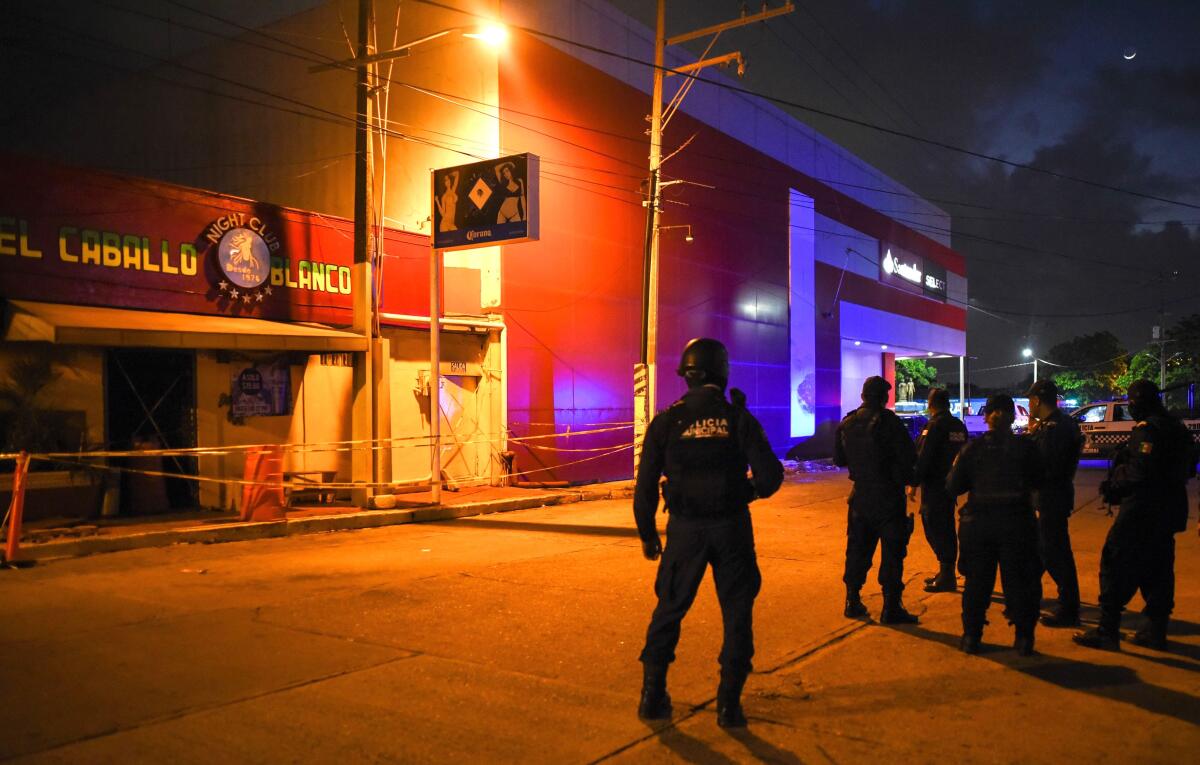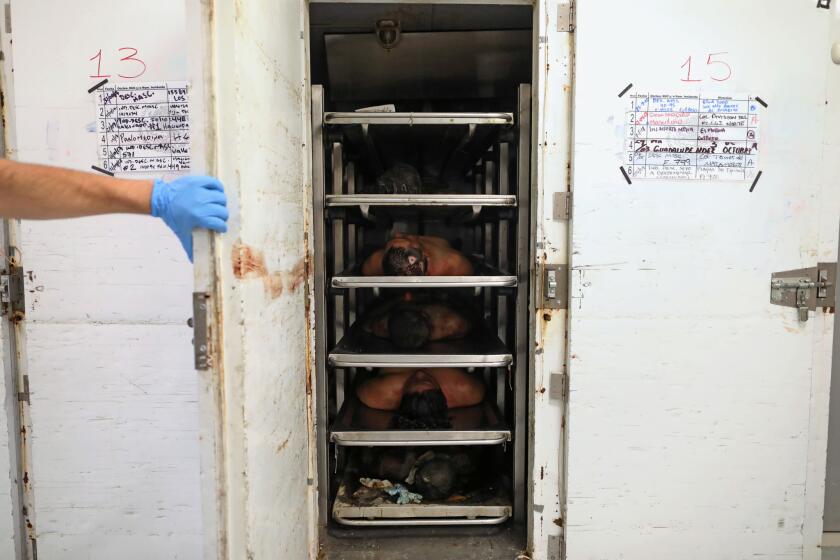Extreme acts of violence in Mexico are on the rise: 27 burned to death at a strip club

- Share via
MEXICO CITY — The assailants locked the doors and emergency exits. Then they doused the strip club with gasoline and set it on fire.
The inferno that engulfed the White Horse bar in southern Mexico on Tuesday night killed 27 people and injured more than a dozen others. Photos taken after the flames were extinguished showed the bodies of semi-nude women strewn amid charred barstools.
The attack, which took place in the Gulf Coast city of Coatzacoalcos, was probably an act of retaliation after the bar owner refused to let a gang sell drugs there, Veracruz Gov. Cuitlahuac Garcia said. The owner was kidnapped before the bar was set ablaze, he said.
The attack came almost eight years to the day after a similar fire at a casino in the northern city of Monterrey killed 52 people, and it raised concerns that Mexico’s criminal groups might be returning to the kind of spectacular acts of violence that characterized earlier periods of insecurity here.
Mexico’s homicide rate is at the highest level in its recorded history, with an average of 90 people slain each day. Yet in recent years, much of the violence has played out like a low-intensity war, with a high number of individual killings yet fewer mass murders designed to garner grisly headlines.
But that seems to be changing.
Tijuana was the most violent city in the world in 2018, according a new report by a Mexican nonprofit group that ranked cities based on their homicide rates.
In April, 13 people were killed when armed men opened fire at a bar during a family celebration in Minatitlan, Veracruz. On Aug. 8, residents in Uruapan, Michoacan, woke up to news that 19 bodies had been left overnight on a major boulevard, some of them hung from a highway overpass.
There are many reasons why criminal groups might decide to carry out more dramatic acts of violence, analysts say. For example, one criminal group might do so to focus unwanted police attention on a region controlled by another group.
Alejandro Hope, a security analyst based in Mexico City, says such acts are deployed “to buttress the reputation of a particular group.”
“It intimidates rivals,” he said. “It creates fear.”
Speaking at his daily news conference Wednesday morning, President Andres Manuel Lopez Obrador called the bar attack “the most inhuman thing possible.”
The president said officials believed one of the organizers of the attack was a local cartel member identified as Ricardo “N,” who uses the alias La Loca.
The man had recently been arrested but was later released, Lopez Obrador said. He called for local prosecutors to be investigated to see why the alleged perpetrator had been freed.
“It is regrettable that organized crime acts in this manner,” the president said. “It is more regrettable that there may be collusion with authorities.”
The state attorney general’s office responded with a statement denying any collusion and saying that it was federal authorities who were responsible for the release of La Loca.
Such finger-pointing is particularly common in Veracruz, where mistrust among different factions of government is high.
The oil-rich state was governed by a single political faction, the Institutional Revolutionary Party, or PRI, for more than a century until 2016, when then-Gov. Javier Duarte fled the country amid corruption allegations. Duarte was eventually arrested and convicted of charges including criminal association and money laundering.
The center-right National Action Party, or PAN, won an election to replace Duarte in 2016, and the president’s left-leaning Morena party won the governorship two years later.
Such rapid political turnover has disrupted agreements between cartels and public officials, said Falko Ernst, senior analyst for Mexico at the International Crisis Group. It also appears to have created divisions between those in government now aligned with Morena and prosecutors still aligned with PAN.

“There’s no trust between these different fragments of the government,” Ernst said. “They don’t even speak to each other.”
“What we’re seeing is the failure of two political transitions to address the root causes of violence,” he said.
Experts say a separate political change has also hampered Mexico’s ability to fight crime.
The country’s justice system is in the midst of a major overhaul, transitioning from a system based on written arguments to one in which evidence is presented orally.
Most experts agree the transition is needed, but because police and prosecutors have not received proper training in many parts of the country, many cases have been dismissed by judges because of investigation errors.
The transition to the new justice system was underway before Lopez Obrador took office in December, and critics say he has not done enough to support it. In fact, the president has dramatically cut funding across government during his first nine months in office, including to Mexico’s police forces and the attorney general’s office.
“The police have not adapted to the new system, and neither have prosecutors,” said Hope, the security analyst, who served as an advisor to one of Lopez Obrador’s opponents in the 2018 presidential election. “There is chronic underfunding of the criminal justice system, but institution-building is not [Lopez Obrador’s] forte.”
The president’s security strategy has been focused on the creation of two elements: a new national guard and a cash transfer program that provides government funding to young people who are enrolled in school or internships.
Neither has had an immediate effect on crime, which is growing.
What is needed, Hope said, are better-trained police and prosecutors and better enforcement of the country’s laws. Widespread impunity means criminal groups have little incentive to refrain from attacks such as the one on the bar, he said.
“If an extraordinary event like this doesn’t generate an extraordinary reaction, these type of events will just happen again and again.”
More to Read
Sign up for Essential California
The most important California stories and recommendations in your inbox every morning.
You may occasionally receive promotional content from the Los Angeles Times.












